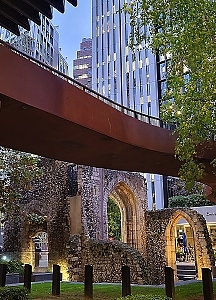Adam Yamey's Blog: YAMEY, page 35
October 29, 2024
The Imaginary Institution of India at London’s Barbican Centre
THE OBJECTS IN an exhibition are usually chosen to fit in with a particular theme. An exhibition might be based on the work of an individual artist or a group of artists; on a style of art (e.g., Impressionism or Expressionism or portraiture); on a specific genre (e.g., etchings or sculpture or paintings or photographs); a period of history. It is the latter theme – a period of history – which has been adopted to create a superb exhibition, “The Imaginary Institution of India” at London’s Barbican gallery. This show is on until the 5th of January 2025.
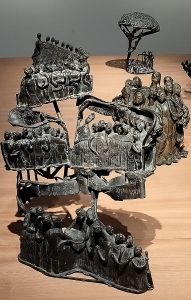
The theme connecting the artworks on display at this exhibition is India during the period from 1975 to 1998. You might well wonder why these years have been singled out. Some landmarks during these years include Prime Minister Indira Gandhi’s proclamation of a state of emergency in 1975; problems in West Bengal (in 1979); the founding of the BJP party; inter-communal problems; the attack on the Golden Temple in Amritsar (1984); the toxic leakage at the Union Carbide plant in Bhopal; Hindu-Muslim tensions in Ayodhya; the destruction of the Babri Masjid (in Ayodhya); terrorist attacks in Bombay; and India’s successful underground nuclear tests. These events and many others occurred during the period covered by the exhibition.
The works on display at the exhibition are, according to the Barbican’s useful handout (a booklet), expressions of the various artists’ reaction to the events and social upheavals occurring in India during the years 1975 to 1998. The booklet describes what the exhibition’s organisers believe were the artists’ (political) messages being expressed in their creations. Interesting as these observations are, the works on display can be enjoyed without having any knowledge of what might have or might not have been going through the artists’ minds while they were producing their artworks. The exhibition provides a wonderful display of the excellence of Indian art produced during the period covered by the show.
I had not heard of most of the artists apart from MF Hussain, Bhupen Khakar, Sudhir Patwardhan, and Arpita Singh. The works that I liked most are by Patwardhan, Singh, Gieve Patel, and some lovely bronzes by Meera Mukherjee. I was also impressed by a set of collages by CK Rajan. That said, almost every work on display is worth seeing. The only disappointment for me was a video-based installation by Nalini Malani.
The Barbican has displayed these works in this exhibition both brilliantly and dramatically. I hope that the seemingly specialised nature of the theme of the exhibition (and its rather odd name) will not deter people from experiencing this superb collection of artworks.
October 28, 2024
Springing up from the ruins
October 27, 2024
Remembering Helen Yamey, who was my mother and an artist
My mother, HELEN YAMEY (1920-1980) was born in South Africa. In 1948, she came to the UK, and by 1952, she had become a sculptor. In the 1950s and ‘60s, she worked in the Sculpture Department of London’s St Martins School of Art alongside now famous sculptors including Elisabeth Frink, Anthony Caro, David Annesley, Eduardo Paolozzi, Menashe Kadishman, William Tucker, and Phillip King. Helen’s work was of a sufficiently high quality for it to be selected for showing in exhibitions that included the above-mentioned artists as well as others including David Hockney, Henry Moore, Barbara Hepworth, Paula Rego, Bridget Riley, Duncan Grant, and Jean Arp. Yet, unlike the artists listed, she and her work have become largely forgotten.
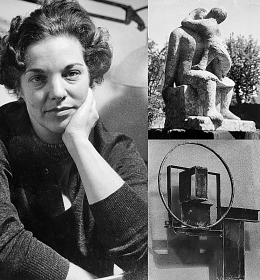
In my biography of Helen, “Remembering Helen: My Mother the Artist”, I describe her career as an artist, what she was like as a person, and explore why she did not make a reputation like those with whom she worked and exhibited. The book contains illustrations of many of Helen’s sculptures, and my daughter, Mala Yamey, an art historian and curator, has written notes about my mother’s sculptural works.
The book is available as a paperback in other Amazon marketplaces, such as https://www.amazon.co.uk/REMEMBERING-HELEN-MY-MOTHER-ARTIST/dp/B0DKCZ7J7X/ .
There is also a Kindle edition.
October 26, 2024
Holy rollers in the centre of Norwich
DURING OUR LAST HOUR in central Norwich, we explored an alley, which we had not noticed before. It led downhill to a churchyard. This surrounded two sides of a mediaeval (late 15th century) church: St Peter Parmentergate. A ‘parmenter’ was a tailor or someone who made facings and trimmings for clothes. The doorway at the southeast corner of the church was open, and two men were standing outside it. We asked them whether we could look inside the church. They said that we could do so, but did not tell us what to expect inside.
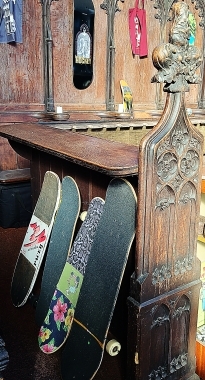
The interior of the church maintains many of its original church-related features, but in all other respects it is quite unusual. The nave of the church has no pews, but instead there is a new wooden floor that curves up at both its east and west ends. The chancel is filled with skateboards, magazines about skateboarding, and a variety of toys. Where there were once kneelers in the choir stalls, there are now skateboards. Elsewhere in the church, there were skateboards galore and helmets for skateboarders. The church is a mecca for skateboarders.
Since 2021, the church has become a skateboarding rink and a shop for skateboards. The owner of this extraordinary establishment told us that he knows of only four churches that have become converted for the use of skateboarders, and one of them is currently out of use.
The church ceased being used as a place of worship in 1980. Since then, it has been maintained by the Norwich Historic Churches Trust (‘NHCT’). Before it became used as a skateboarding centre, it served various purposes. From 2007 until 2017, it housed a centre for martial arts. Next, it was let out to the NHCT. After that, it was used by a counselling specialist.
A few hours before seeing St Peters Parmentergate, we had visited St Gregory’s, a church converted to an antiques shop. That surprised us, but not as much as St Peters Parmentergate, which must be seen to be believed. It is good to see those churches in Norwich, which have ceased serving the purpose for which they were built, are being both looked after and being kept alive as part of the city’s life.
October 25, 2024
Tipu Sultan on ceramic plates in London’s Mayfair
ADEELA SULEMAN IS an artist based in Karachi (Pakistan). She was born in 1970 and educated at the University of Karachi. In an exhibition at London’s Grosvenor Gallery, a collection of her works relating to the life of Tipu Sultan (the ‘Tiger of Mysore’: 1751-1799) is on display until the 25th of October 2024.
For those who are unaware of his fame, Tipu Sultan (son of Hyder Ali) ruled the independent kingdom of Mysore, and defended it against the attacks of the British. However, in the end, he was killed while defending his fortress at Srirangapatna. Before his demise, he was forced to deliver two of his sons to be held by the British as hostages. This happened in 1792. His death 7 years later was due to treachery within his court.
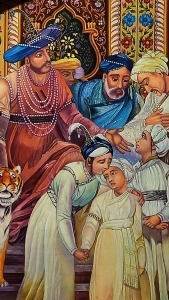
Adeela Suleyman has painted exquisite scenes depicting stages in Tipu’s life. The paintings have been created on vintage ceramic plates (platters). Each plate is surrounded by an elaborately carved timber picture frame. The paintings are rich in detail, and reminded me of Persian or Mughal miniatures. They portray episodes of Tipu’s story colourfully and vividly. Each of the images is a delight to see. What the artist has created is an attractive and respectful memorial to a great man. According to the gallery’s catalogue, the images can be sold separately, but it would be a shame to have this collection dispersed; it would be better to keep it intact.
In addition to the painted plates, there are some sculptural items (relating to Tipu) created by the artist. although they are eye-catching, it is the painted plates that appealed to me much more.
October 24, 2024
Antiques in the aisles within a church in Norwich
THE CITY OF NORWICH used to have about 100 churches. Today, there are about 73 churches in use as places of worship. That is approximately one church for every 1900 people. Many of Norwich’s churches are no longer used for worship, but being of historic and architectural value, they are kept standing. One of these redundant churches is St Gregory’s in the heart of the city. It was constructed in the 14th century, and has been designated a Grade 1 Listed Building. Closed in 1971, it is looked after by the Norwich Historic Churches Trust.
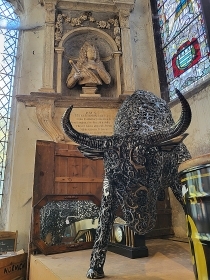
On entering St Gregory’s, you are confronted by models of deer with antlers standing in the porch alongside all manner of ‘junk’. Beyond this, there is a glass fronted refrigerator containing cans of carbonated drinks. On entering the body of the church, the visitor is confronted by all manner of used goods (including antiques) arranged picturesquely in the aisles, the chancel, and other parts of the church. When the initial surprising impact of the church is over, one notices features of the original church that still remain: the stone font; the royal coat of arms; stained glass windows; funerary sculptures; the organ; and a fine wall painting of St George and the dragon. Towering above the sea of goods, there is beautiful gothic vaulting.
Since 2011, the church has been used as an antiques centre (actually, it is more like an indoor flea market). The variety of goods on sale is huge. Beneath the organ, where the choir stalls must have been, there is a second-hand book seller. Despite the somewhat Bohemian look about this stall, the books are not moderately priced.
Whether or not one has any interest in purchasing antiques, St Gregory’s is well worth a visit because what has been created within it is much better than many immersive installations created by professional artists.
October 23, 2024
A garden of funkiness in London’s Kensington
THE SERPENTINE GALLERY rarely puts on exhibitions that can be described as ‘mundane’. It is the most exciting and adventurous public art gallery in London. True to form, its current show (in the South gallery) is both weird and unexpected – actually, quite funky. Called “Emajendat” (i.e., ‘imagine that’), it is on until the 2nd of March 2025. The exhibition or art installations were created by Lauren Halsey, who was born in 1987 in Los Angeles (USA), where she lives and works.
Ms Halsey has created a series of fantasy landscapes that reflect the backyard culture of the part of Los Angeles – South Central – where was brought up and still lives. The exhibition’s leaflet explained that she:
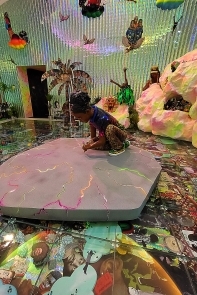
“… has developed a distinct visual language deeply rooted in South Central Los Angeles where her family has lived for generations. Through objects and installations, Halsey archives and remixes the changing signs and symbols of her environment, gathering physical and graphic material from her neighbourhood. In her work Halsey merges past, present and future via her interest in iconography connected to the African diaspora, Black and queer icons and architecture. Halsey cites the collective sonic and visual layering associated with funk music as the blueprint for her approach to making, traversing time and drawing on a wide range of sources.”
The extraordinary environments she has created in the various spaces within the Serpentine have a humorous dreamlike quality, and at the same time contain her comments on the social culture of Los Angeles. These comments and her message as described in the gallery’s leaflet were lost on me, but I enjoyed the visual impact and creativity of what I saw. From a purely aesthetic point of view, this extraordinary exhibition is like the proverbial ‘breath of fresh air’.
October 22, 2024
Country and eastern in the heart of Norwich
DURING THE 1970s, Philip and Jeannie Millward began collecting folk art and other artefacts in the Swat Valley of Pakistan. Over the years, these intrepid travellers have been collecting folkloric and other objects from all over south Asia: from Pakistan, India, Indonesia, and so on. At first, they stored their growing collection in a warehouse in Norwich. The Millwards’ collection grew and grew and included things bought from auctions and dealers in the UK. Today, a part of what they have amassed is beautifully displayed in a building with an interesting history.
The Millwards’ South Asia Collection is housed in a huge building, which opened in 1876. It was designed to be an indoor roller-skating rink. However, by 1877, this enterprise failed, and the building became used for Vaudeville theatre. Five years later, it became a Salvation Army ‘citadel’, and then in 1898, it became a builders’ merchant’s storehouse. In 1993, the edifice was purchased by the Millwards, who converted it to become a museum to display items from their collection.
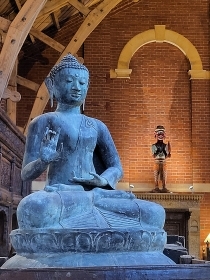
The museum’s exhibits are beautifully laid out, and clearly labelled. Many of the objects on display are very fine examples of their type. I have seen only few museums in India that come up to the high standard of this museum in Norwich. Many of the fine pieces that the Millwards have brought from the Indian subcontinent and elsewhere in the past might not now be allowed to leave their countries of origin. But luckily, they have come to Norwich where they are being expertly cared for. The museum is not simply a display place. It works with academic institutions such as CEPT University in Ahmedabad (Gujarat) to carry out research projects that help put objects in the collection into their true context.
Although the museum is the main attraction of the place, the former roller-skating rink also houses a shop where finely crafted, high quality folkloric goods, sourced in India and other places, can be bought. What is on sale has been purchased directly from the craftspeople who made them, rather than from middlemen. And the prices attached to them are very reasonable – not much greater than one would expect to pay in good handicraft shops in India.
Norwich is filled with attractions for the visitor. Less well-known than the castle, the cathedral, and the Sainsbury Centre for Visual Arts, the Millward’s South Asia Collection in Bethel Street should become one of the first places a visitor heads for.
October 21, 2024
Fondue memories and a charming glockenspiel in central London
IN THE 1970S, I used to love eating at the now demolished Swiss Centre on the northwest corner of Leicester Square. Its restaurant was pricey, but served great cheese fondue and steak tartare. Sadly, the Swiss Centre is no more, but there is a lovely souvenir still standing. It is a glockenspiel with bells and animated models of animals and Swiss farmers, which rotate whilst the bells are chiming. It is a bit kitsch but completely charming.
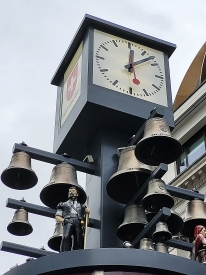
The original glockenspiel was installed in 1985, then removed in 2008. It was reconstructed in about 2011. It has 27 bells, 2 clocks, and 11 moving figures. The show can be watched once every few hours during daytime. A timetable is attached to the lovely apparatus. Compared to much else that now happens in Leicester Square, the glockenspiel has real class.
October 20, 2024
Towering above Norwich Market
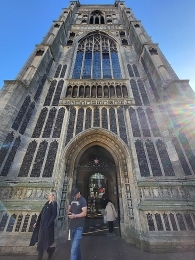
This is the tower of the 15th century St Peter Mancroft in Norwich, Norfolk. Situated next to the market place, this is the city’s parish church. It is the centre of civic worship, whereas the magnificent cathedral is the ecclesiastical centre of the city’s worship. Both this church and the cathedral make a visit to Norwich worthwhile. The city has other magnificent attractions, which I will write about soon.

